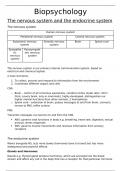Biopsychology
The nervous system and the endocrine system
The nervous system
Human nervous system
Peripheral nervous system Central nervous system
Autonomic nervous Somatic nervous Brain Spinal cord
system system
Sympathe Parasympath
tic etic nervous
nervous system
system
The nervous system is our primary internal communication system, based on
electrical and chemical signals.
2 main functions:
1. To collect, process and respond to information from the environment
2. Coordinate different organs and cells
CNS:
o Brain – centre of all conscious awareness, cerebral cortex (outer later, 3mm
thick, covers brain, only in mammals), highly developed, distinguishes our
higher mental functions from other animals, 2 hemispheres
o Spinal cord – extension of brain, passes messages to and from brain, connects
nerves to PNS, reflex actions
PNS:
Transmits messages via neurons to and from the CNS.
ANS: governs vital functions in body e.g. breathing, heart rate, digestion, sexual
arousal, stress responses
SNS: governs muscle movements and receives information from sensory
receptors
The endocrine system
Works alongside NS, acts more slowly (hormones have to travel) but has more
widespread and powerful effects.
Glands and Hormones
Glands e.g. thyroid gland produce hormones, which are secreted into the blood
stream and affect any cell in the body that has a receptor for that particular hormone.
,As most hormones affect multiple organs, they have diverse and powerful responses.
e.g. Thyroid gland produces thyroxine – this hormone affects cells in the heart
(increases heart rate) and increases metabolic rates elsewhere, which affects growth
rates.
The pituitary gland located in the brain is often called the ‘master gland’ because it
controls the release of hormones from all the other endocrine glands in the body.
Fight or flight
Endocrine and ANS work in parallel when a in a stressful situation.
1. Stressor is perceived
2. Hypothalamus activates the pituitary gland
3. Activity triggered in sympathetic branch of the ANS
4. ANS changes from resting (parasympathetic) to physiologically aroused
(sympathetic)
5. Adrenaline (stress hormone) released from adrenal medulla into bloodstream
and triggers physiological changes – physiological arousal for fight or flight
This is an immediate, acute, automatic response.
Sympathetic Parasympathetic
Increases heart rate Decreases heart rate
Increases breathing rate Decreases breathing rate
Dilates pupils Constricts pupils
Inhibits digestion Stimulates digestion
Inhibits saliva production Simulates saliva production
Contracts rectum Relaxes rectum
These changes explain why stress is often experienced as a ‘sick’ feeling.
6. Parasympathetic NS returns body to resting state
The actions of the Parasympathetic NS are antagonistic to the sympathetic – acts as a
‘brake’ and reduces activities increase by the sympathetic. It is known as ‘rest and
digest’.
Neurons and synaptic transmission
Neurons transmit signals electrically and chemically, thus giving the nervous system
its primary means of communication.
Sensory Relay Motor
Images
, Dendrites Long Short Short
Axons Short Short Long
Connecti PNS to CNS Sensory to motor/relay CNS to effectors e.g.
on muscles/glands
Structure of neurons:
Cell body (soma) has a nucleus containing the genetic material of the cell.
Branchlike dendrites protrude from the cell body, carrying nerve impulses from
neighbouring neurons to the cell body.
Axon carries impulses away from cell body down neuron. Covered in fatty layer of
myelin sheath segmented by gaps (nodes of Ranvier) which speed up transmission by
forcing impulse to ‘jump’ across the gaps.
At end of axon are terminal buttons, communicate across synapse with next neuron in
chain.
Location of neurons:
Cell bodies of motor neurons in CNS, axons part of PNS.
Sensory neurons outside CNS, in the PNS in clusters (ganglia).
Relay neurons make up 97% of all neurons and most are found in brain/visual system.
Electrical transmission – the firing of a neuron:
1. When a neuron in resting state, the inside of cell is negatively charged
compared to the outside
2. Neuron activated by a stimulus
3. Inside of cell becomes briefly positively charged, causing an action potential to
occur
4. Creates an electrical impulse that travels down the axon towards the end of the
neuron
Synaptic transmission
Chemical transmittion:
Neurons communicate in groups (neural networks), each separated by gap (synapse).
Signals within neurons are transmitted electrically, but between chemically.
1. Electrical impulse reaches the end of the neuron (presynaptic terminal)
2. Triggers the release of neurotransmitter from tiny sacs – synaptic vesicles





